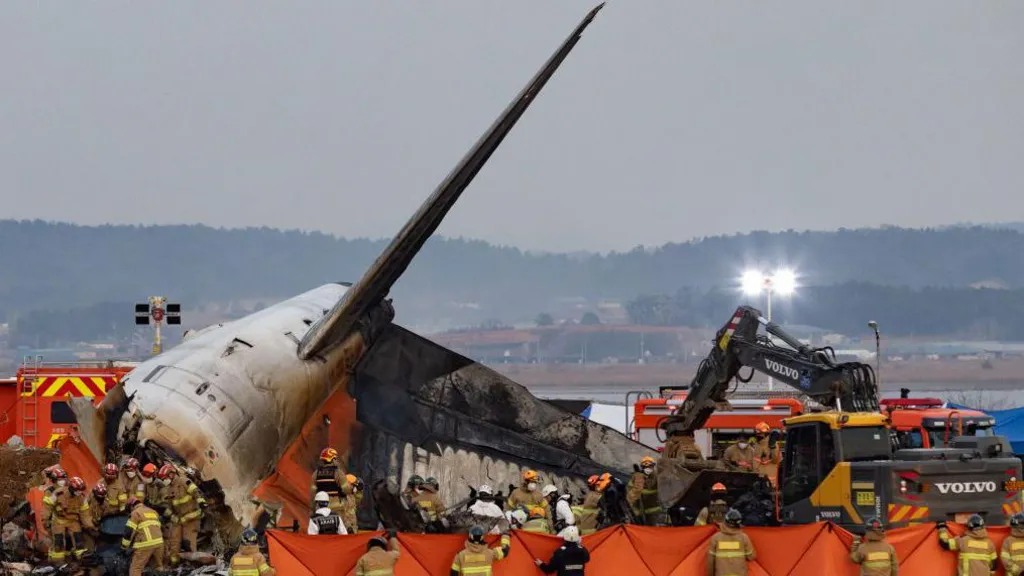In the wake of the tragic crash that claimed 179 lives in December of last year, South Korea has announced significant changes to its airport safety protocols. The country’s Ministry of Land confirmed that all South Korean airports will be required to install bird detection cameras and thermal imaging radars by 2026. This decision follows a comprehensive investigation into the crash of a Jeju Air flight, a Boeing 737-800, which crashed during an emergency landing after hitting a bird. The crash, which remains the deadliest on South Korean soil, has underscored the importance of enhancing airport safety measures to prevent similar disasters in the future. The investigation revealed disturbing evidence of a bird strike, with blood stains and feathers found on both of the plane’s engines, pointing to the bird’s impact as a crucial factor in the chain of events that led to the fatal accident.
The flight had taken off from Bangkok, heading toward Muan International Airport in the country’s southwest. Just three minutes after the crew contacted the control tower, they were warned about possible bird activity in the vicinity. Shortly thereafter, the pilot reported that the plane had struck a bird and declared a mayday. Despite the distress call, the pilot attempted to land the aircraft without its landing gear deployed, which resulted in a belly landing. The plane skidded off the runway and crashed into a concrete structure at the end of the runway. The collision with the concrete structure caused an explosion, making it the deadliest air crash on South Korean soil. Among the 179 passengers and crew, the majority were in their 40s, 50s, and 60s, and the two cabin crew members were the only survivors.
The crash has brought attention to the need for increased safety measures, particularly in preventing bird strikes, which pose a significant risk to aviation. As part of the country’s efforts to address this, the Ministry of Land has committed to installing bird detection radars across all airports. These radars are capable of detecting birds’ size, movement, and trajectories, providing air traffic controllers with timely data to assist in preventing collisions. In addition to the radar system, each airport will also be equipped with at least one thermal imaging camera, which can help identify birds at night or in low-visibility conditions. At present, only four airports in South Korea are equipped with thermal imaging cameras, and it is unclear if they currently have bird detection radars installed. These new safety systems are set to roll out by 2026, aiming to significantly enhance the country’s aviation safety standards.
The government is also taking steps to address the presence of birds near airports by relocating sites that attract birds, such as rubbish dumps, further away from airport facilities. This strategy is aimed at minimizing the risk of bird strikes by reducing the number of birds that come into proximity with aircraft during takeoff and landing. In addition to the bird detection measures, South Korea is also modifying runway safety areas at seven airports, based on a recent safety review conducted after the December crash. This review identified certain areas of concern that could exacerbate the consequences of an emergency landing, prompting the government to make changes to improve runway safety and reduce the likelihood of similar accidents.
The changes in South Korean aviation safety practices come after mounting concerns from air safety experts, who believe the crash’s death toll could have been significantly lower if the plane had not collided with the concrete structure after making its emergency landing. In the aftermath of the tragedy, experts have emphasized that the current crash investigation is likely to focus on the role of the bird strike and the impact of the concrete runway structure. Flight data and cockpit voice recorders stopped recording four minutes before the crash occurred, but an ongoing review of these black boxes aims to provide further insight into the final moments of the flight and whether the bird strike played a decisive role in the outcome.
This fatal incident has sparked a broader conversation about the need to strengthen airport safety protocols to prevent bird strikes and other similar hazards. The steps South Korea is taking to implement bird detection technology and improve runway safety reflect a commitment to ensuring that the country’s airports are better prepared to deal with potential risks in the future. As the investigation into the crash continues, the hope is that these new measures will help safeguard passengers and crew, preventing a repeat of this tragic event.
As part of South Korea’s ongoing efforts to improve air travel safety, the installation of bird detection radars and thermal imaging cameras will be a key part of the country’s aviation strategy going forward. The rollout of these systems will undoubtedly help reduce the risk of bird strikes, and the government’s commitment to addressing bird-related safety hazards is a step in the right direction for aviation safety. In the wake of such a devastating crash, the measures taken to improve airport safety will not only benefit South Korea but also set an important example for airports around the world.
For more updates on aviation safety and the latest developments in air travel, stay connected with The Innovation Times. Join us on WhatsApp or Telegram to receive real-time updates on breaking news and industry trends.



